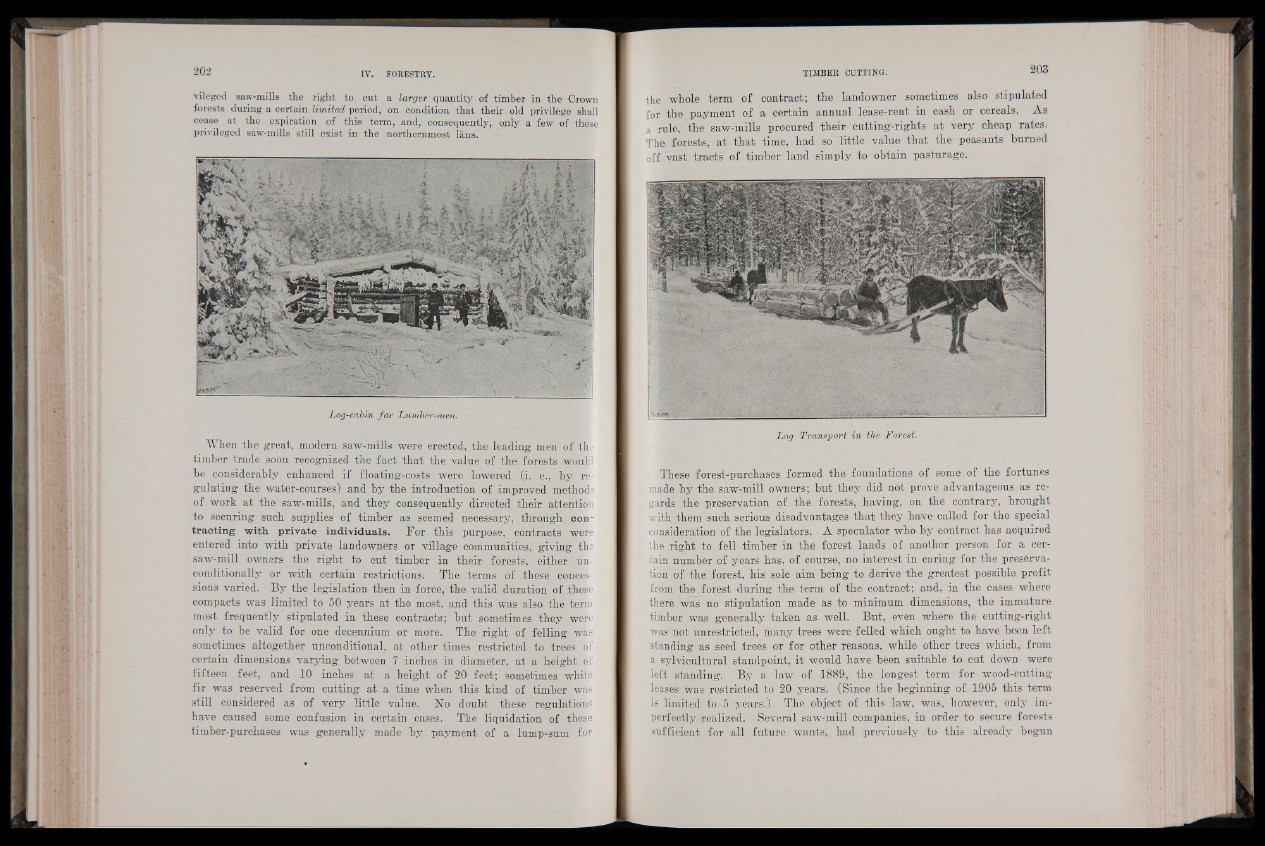
vileged saw-miUs the right to cut a larger quantity of timber in the Crown
forests during a certain limited period, on condition that their old privilege shall
cease at the expiration of this term, and, consequently, only a few of these
privileged saw-mills still exist in the northernmost Ians.
Log-cabin fo r Lumber-men.
When the great, modern saw-mills were erected, the leading men of the
timber trade soon recognized the fact that the value of the forests would
be considerably enhanced if floating-costs were lowered (i. e., by regulating
the water-courses) and by the introduction of improved methods
of work at the saw-mills, and they consequently directed their attention
to securing such supplies of timber as seemed necessary, through contracting
with private individuals. For this purpose, contracts were
entered into with private landowners or village communities, giving the
saw-mill owners the right to cut timber in their forests, either unconditionally
or with certain restrictions. The terms of these concessions
varied. By the legislation then in force, the valid duration of these
compacts was limited to 50 years at the most, and this was also the term
most frequently stipulated in these contracts;' but sometimes they were
only to be valid for one decennium or more. The right of felling was
sometimes altogether unconditional, at other times restricted to trees of
certain dimensions varying between 7 inches in diameter, at a height of
fifteen feet, and 10 inches at a height of 20 feet; sometimes white
fir was reserved from cutting at a time when this kind of timber was
still considered as of very little value. No doubt these regulations
have caused some confusion in certain cases. The liquidation of these
iimber-purchases was generally made by payment of a lump-sum for
the whole term of contract; the landowner sometimes also stipulated
for the payment of a certain annual lease-rent in cash or cereals. As
a rule, the saw-mills procured their cutting-rights at very cheap rates.
The forests, at that time, had so little value that the peasants burned
off vast tracts of timber land simply to obtain pasturage.
Log Transport in the Forest.
These forest-purchases formed the foundations of some of the fortunes
made by the saw-mill owners; but they did not prove advantageous as regards
the preservation of the forests, having, on the contrary, brought
with them such serious disadvantages that they have called for the special
consideration of the legislators. A speculator who by contract has acquired
the right to fell timber in the forest lands of another person for a certain
number of years has, of course, no interest in caring for the preservation
of the forest, his sole aim being to derive the greatest possible profit
from the forest during the term of the contract; and, in the cases where
there was no stipulation made as to minimum dimensions, the immature
timber was generally taken as well. But, even where the cutting-right
was not unrestricted, many trees were felled which ought to have been left
standing as seed trees or for other reasons, while other trees which, from
a sylvicultural standpoint, it would have been suitable to cut down were
left standing. By a law of 1889, the longest term for wood-cutting
leases was restricted to 20 years. (Since the beginning of 1905 this term
is limited to 5 years.) The object of this law, was, however, only imperfectly
realized. Several saw-mill companies, in order to secure forests
sufficient for all future wants, had previously to this already begun